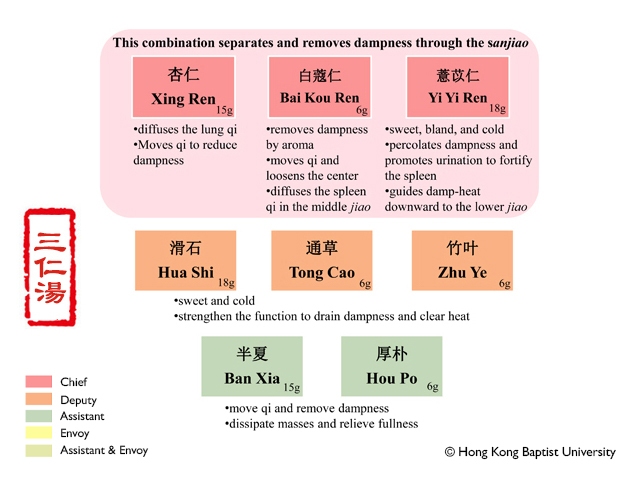| 【Chinese Name】 |
三仁湯
|
| 【Phonetic】 |
San Ren Tang
|
| 【English Name】 |
Three Kernels Decoction |
| 【Classification】 |
Dampclearing formulas |
| 【Source】 |
《Systematic Differentiation of Warm Diseases》Wen Bing Tiao Bian《溫病條辨》 |
| 【Combination】 |
Armeniacae Semen Amarum (Xing Ren) 5 qian (15g), Talcum (Hua Shi) 6 qian (18g), Tetrapanacis Medulla (Tong Cao) 2 qian (6g), Amomi Fructus Rotundus (Bai Dou Kou) 2 qian (6g), Lophatheri Herba (Zhu Ye) 2 qian (6g), Magnoliae Officinalis Cortex (Hou Po) 2 qian (6g), Coicis Semen (Yi Yi Ren) 6 qian (18g), Pinelliae Rhizoma (Ban Xia) 5 qian (15g) |
| 【Method】 |
Prepare as a decoction. |
| 【Action】 |
Disperses and diffuses qi movement, clears and removes damp-heat. |
| 【Indication】 |
San Ren Tang is indicated for the pattern of more dampness than heat in the early stage of damp-warmth and summerheat-warmth with dampness. The symptoms are headache, aversion to cold, heavy body, general pain, fatigue, a light yellow complexion, chest distress without hunger, afternoon fever, and no thirst. The tongue coating is white and the pulse is wiry, thin, and soggy. |
| 【Pathogenesis】 |
San Ren Tang is a common formula used in the early stages of damp-warmth where the pathogen is in the qi level with more dampness than heat. Generally, there are two causes for this condition. One is external damp-heat contraction. The other is internal dampness and fluid accumulation with external pathogen contraction. When the internal and external pathogens mix together, damp-warmth is the result. When wei yang is obstructed by dampness, there is headache and aversion to cold. Symptoms such as a heavy body, general pain, and fatigue are induced because of the heavy, turbid nature of dampness. When damp-warmth stagnates in the spleen and stomach, there will be a dysfunction of transformation and a blockage of qi movement causing chest distress without hunger. Dampness is a yin pathogen that is active between 3 to 7 pm. Thereby, afternoon fever results from the conflict between zheng qi and pathogenic qi. |
| 【Clarification】 |
This is a confusing pattern that is easily mistreated. Aversion to cold is caused by dampness blocking wei yang which differs from an exterior pattern. Afternoon fever is caused by damp-heat accumulation which differs from the tidal fever due to yin deficiency. Doctor Wu Tang reported three prohibitions in his Systematic Differentiation of Warm Diseases. First, one is prohibited to induce sweating when aversion to cold and headache are seen because sweating damages heart yang. Unconsciousness, deafness, and an inability to open the eyes and mouth may result otherwise. Second, one is prohibited to apply the purgative method when there is fullness of the middle jiao without hunger because purgatives damage the spleen and stomach. Dampness might invade the lower jiao and lead to through-flux diarrhea as a result. Third, one is prohibited to apply yin-nourishing medicinals when an afternoon fever is seen because dampness is a yin pathogen. Otherwise, the dampness and the yin medicinals might mix to cause a lingering and stubborn pathogen. The correct therapeutic methods are to diffuse and disperse qi movement, clear heat, and drain dampness. |
| 【Application】 |
1. Essential pattern differentiation
San Ren Tang is applicable to patterns of more dampness than heat in the early stages of damp-warmth. This clinical pattern is marked by headache and aversion to cold, heavy body and general pain, fever at afternoon, white tongue coating without thirst.
2. Modern applications
This formula may be used in the following biomedically defined disorders when the patient shows signs of dampness more than heat: typhoid, gastroenteritis, pyelonephritis, Brucellosis, glomerulonephritis, and arthritis.
3. Cautions and contraindications
This formula is not applicable for patients with heat more than dampness marked by a yellow and greasy tongue coating. |
| 【Additonal formulae】 |
1. Huo Po Xia Ling Tang (Agastache, Magnolia, Pinellia and Poria Decoction 藿朴夏苓湯)
[Source]《Bases of Medicine recorded in A Summary of Externally-contracted Syndromes》Gan Zheng Ji Yao‧Yi Yuan《感證輯要‧醫原》
[Ingredients] Huo xiang 2 qian (6g), ban xia 1.5 qian (4.5g), chi fu ling 3 qian (9g), xing ren 3 qian (9g), yi yi ren 4 qian (12g), bai dou kou 1 qian (3g), tong cao 1 qian (3g), zhu ling 3 qian (9g), dan dou chi 3 qian (9g), ze xie 1.5 qian (4.5g), hou po 1 qian (3g)
[Preparation and Administration] Prepare it as a decoction.
[Actions] Releases the exterior and removes dampness.
[Applicable Patterns] Early stages of damp-warmth. Symptoms include: fever and aversion to cold, fatigue, chest oppression, greasy sensation in the mouth, a thin and white coating, and a soggy and slow pulse.
2. Huang Qin Hua Shi Tang (Scutellaria and Talcum Decoction 黃芩滑石湯)
[Source]《Systematic Differentiation of Warm Diseases》Wen Bing Tiao Bian《溫病條辨》
[Ingredients] Huang qin 3 qian (9g), hua shi 3 qian (9g), fu ling pi 3 qian (9g), da fu pi 2 qian (6g), bai dou kou 1 qian (3g), tong cao 1 qian (3g), zhu ling 3 qian (9g)
[Preparation and Administration] Prepare it as a decoction.
[Actions] Clears heat and drains dampness.
[Applicable Patterns] Damp-warmth in the middle jiao. Symptoms include: fever and general pain, the fever feeling as though it has been released with sweating but then recurs, thirst without drink, a light, yellow and wet tongue coating, and a slow pulse. |
|
|




